Cabbage paratha (or Patta Gobhi ka Paratha) is a delicious and healthy whole wheat flatbread stuffed with a spiced cabbage stuffing. It is one of the lesser-known paratha variety made in North Indian homes for breakfast. However, you can also make it for lunch or as an evening tea time snack.
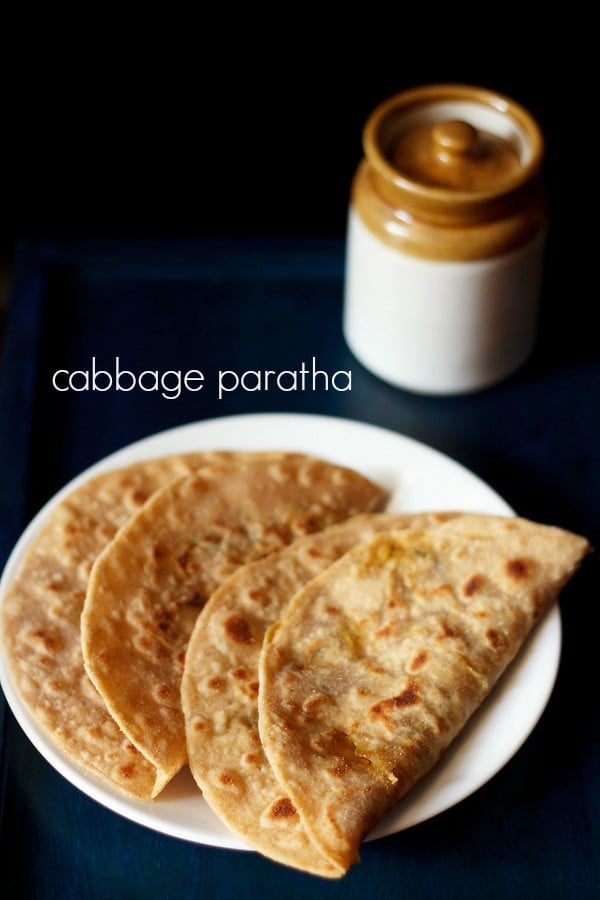
There are two ways cabbage paratha can be made. One method is kneading flour with finely chopped cabbage and spices. This is the easiest method to make cabbage paratha. The second method is to stuff the paratha with a spiced cabbage stuffing. Both ways the parathas taste good.
Cabbage paratha is also called as patta gobhi ka paratha. In Hindi cabbage is known as ‘patta gobhi’ or ‘patta gobi’.
The method shared here is the second method. These no onion no garlic patta gobhi paratha make for a healthy breakfast as well as make for a good tiffin box brunch or lunch.
If you have some cabbage left behind after using it in some other recipes, then you could use that cabbage to make these parathas. It is a good way to use leftover cabbage. These parathas can be made with both the regular green cabbage and purple cabbage.
Serve cabbage paratha hot or warm with a side of mango pickle or lemon pickle or some yogurt or butter. For best taste have them hot as they are made on tawa (skillet) and then directly served on your plate.
How to make Cabbage Paratha
Prepare Dough
1. In a mixing bowl or pan take 2 cups whole wheat flour, 2 teaspoons oil, ¼ to ½ teaspoon salt or add as required. Also add ⅔ cup water.
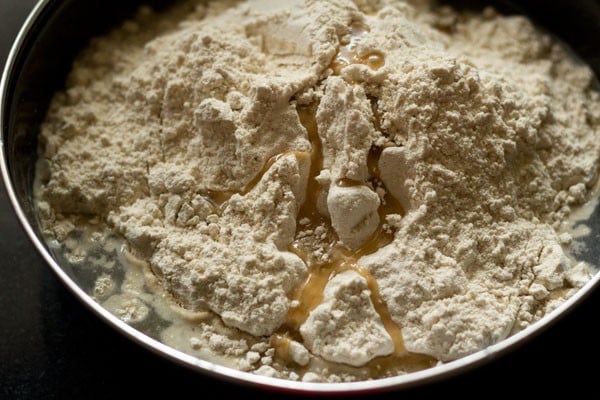
2. Mix all the ingredients and then knead the dough. Add more water if required to make a smooth soft and pliable dough. Cover and allow the dough to rest for 20 to 30 minutes.
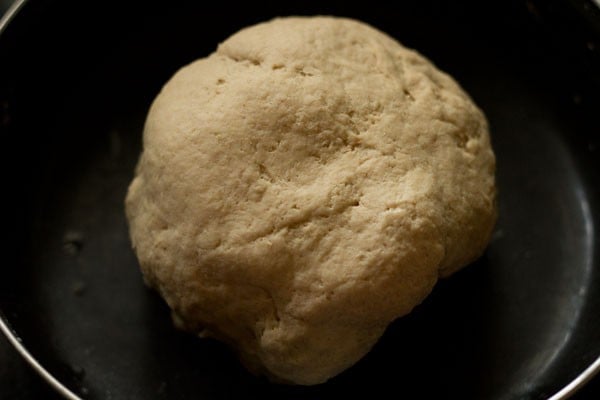
Prepare cabbage stuffing
1. Peel and remove the top skin from the cabbage (patta gobhi or band gobi). Rinse and quarter the cabbage and blanch in hot water for 5 to 10 minutes.
Drain all the water and then shred cabbage or chop it. I used 350 grams of cabbage, which yielded 4 cups of tightly packed shredded cabbage.

2. Heat 1 tablespoon oil in a heavy pan or kadai. Keep the heat to low. Splutter ½ teaspoon ajwain seeds (carom seeds). You can also use ½ teaspoon cumin seeds instead of ajwain seeds.
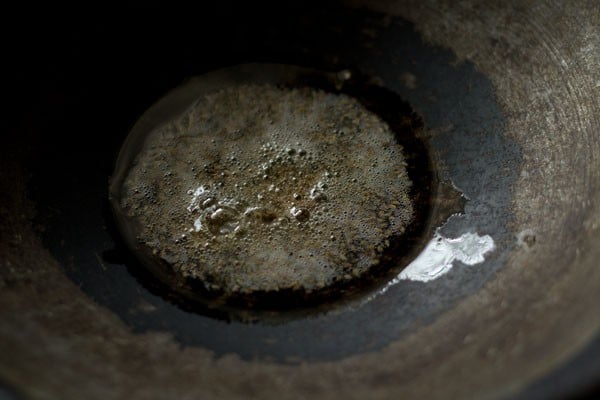
3. Then add the shredded cabbage. Stir and mix very well.
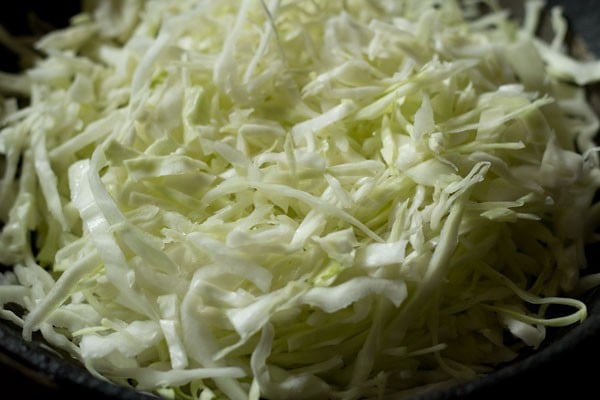
4. Season with salt as required.

5. Cover the pan with a lid.
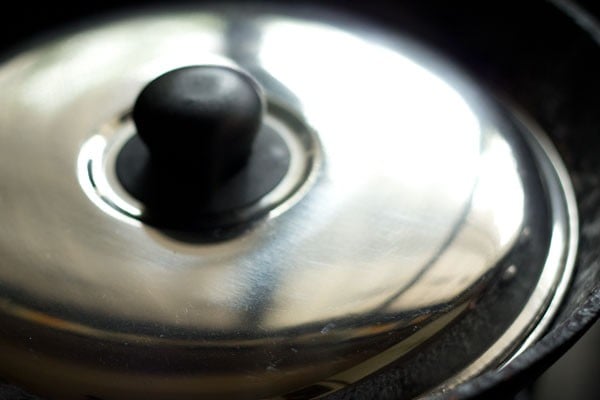
6. Steam the shredded cabbage on a low heat till they turn translucent. This takes about 7 to 8 minutes on a low heat. Do stir once or twice when the cabbage is cooking.
If the cabbage starts sticking to the pan or getting browned, add a splash of water and deglaze. Continue to cover and cook. Keep in mind that the stuffing when cooked should not have any water in it.
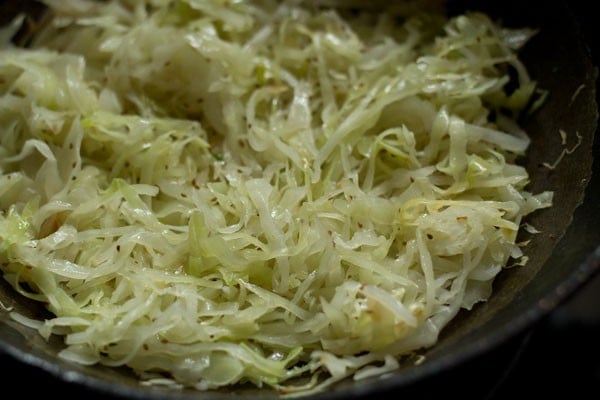
7. Then add the following ingredients:
- 1 teaspoon finely chopped green chilies
- 1 teaspoon finely chopped ginger
- ¼ teaspoon turmeric powder
- ¼ teaspoon red chilli powder
- ½ teaspoon coriander powder
- ½ teaspoon cumin powder
- ½ teaspoon garam masala powder
- ½ teaspoon amchur powder (dry mango powder).

8. Mix the spice powders very well with the cabbage. Check the taste and add more salt, red chili powder or dry mango powder if required.

9. Lastly add 2 tablespoons of coriander leaves. Switch off the heat.
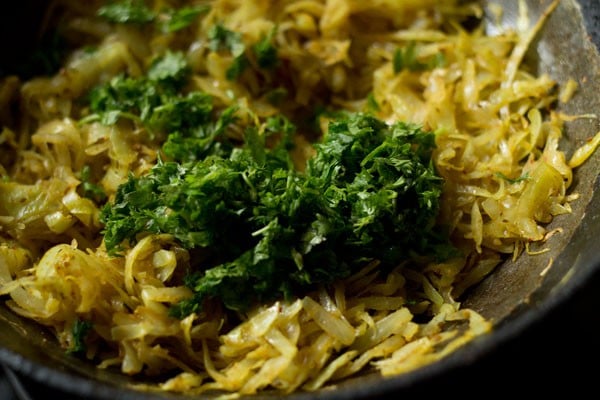
10. Mix the coriander leaves very well with the rest of the spiced cabbage stuffing. Allow this stuffing to cool down at room temperature.
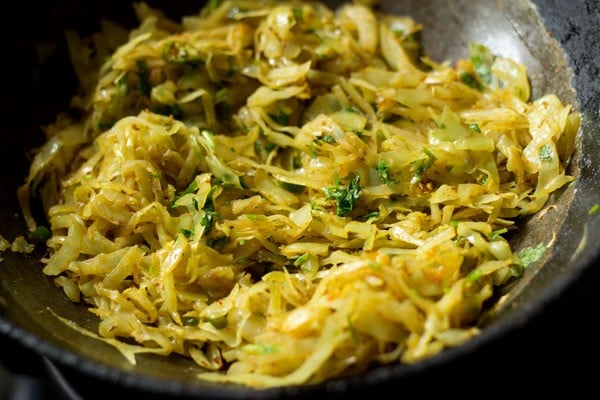
Assemble and stuff cabbage paratha
1. Later pinch two small to medium sized balls from the dough. On a rolling board, dust some dry wheat flour on both sides of the balls.

2. Roll them to about 4 to 5 inches diameter rounds. Try making both the rounds of the same size.
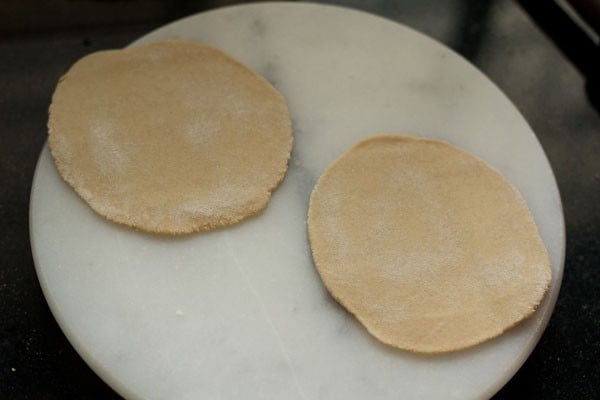
3. On one of the rolled dough circle, place the cabbage stuffing in the center and keep about 1 inch empty space from the sides.
TIP 1: Don’t overstuff the paratha as then the stuffing might come out while rolling or roasting the paratha.
TIP 2: Don’t under stuff the paratha as then you won’t get the spiced cabbage flavor in the paratha. As you keep making parathas then with experience you will get to know what should be the right amount of stuffing to be added.
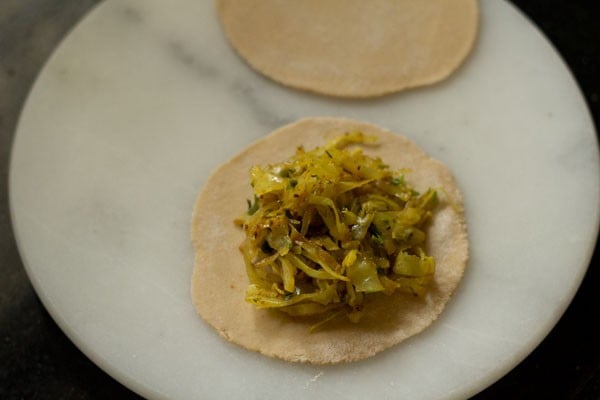
4. Gently place the second circle on top. Press and seal the edges very well with your fingertips.

5. Dust some flour on both sides of the stuffed paratha. Roll the paratha into a circle of about 7 to 8 inches in diameter or about the size of a normal roti or chapati. If there are a few small tears in the rolled paratha, then it is fine.
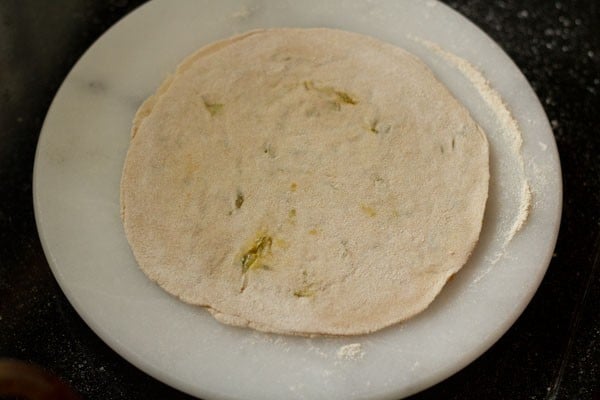
Cook Patta Gobhi ka Paratha
1. On a hot tawa or skillet or griddle place the rolled paratha. The tawa should be hot and not at a low temperature. Cooking parathas at a low flame will harden them. Parathas ideally are crisp as well as soft.
Keep the heat from medium to high depending upon the heaviness and weight of the skillet or tawa.
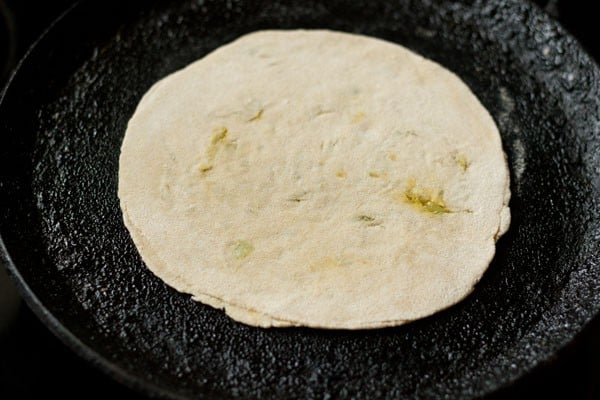
2. When the base is partly cooked, flip the cabbage paratha with the help of tongs or a spatula. Then with a spoon spread some ghee or oil on the partly cooked part.
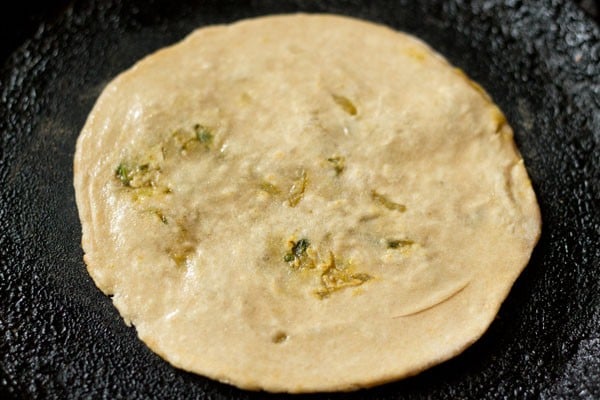
3. Flip again and this time this side has to be cooked more than the previous side. You will see brown spots on the patta gobhi paratha.
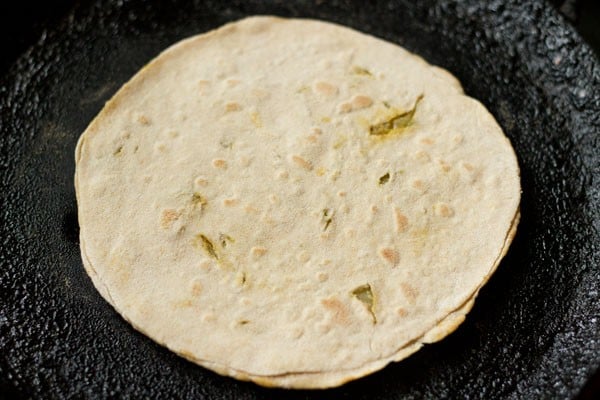
4. Spread some ghee or oil on this side of the paratha too.

5. Flip again once or twice till both the sides are cooked properly.
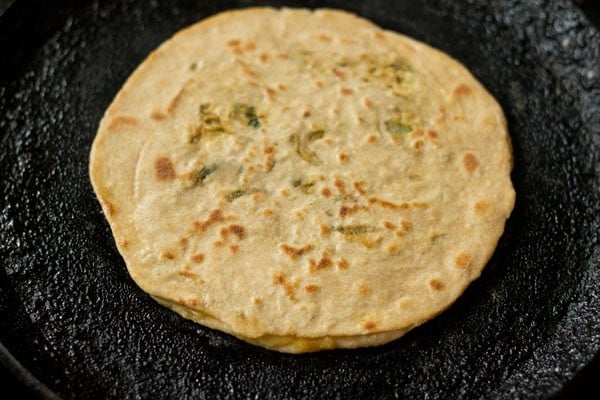
6. You should see crisp brown spots on the stuffed cabbage paratha. You can also press the paratha edges with a spatula or spoon, so that they are fried well. Since at times, the paratha edges are not cooked well.
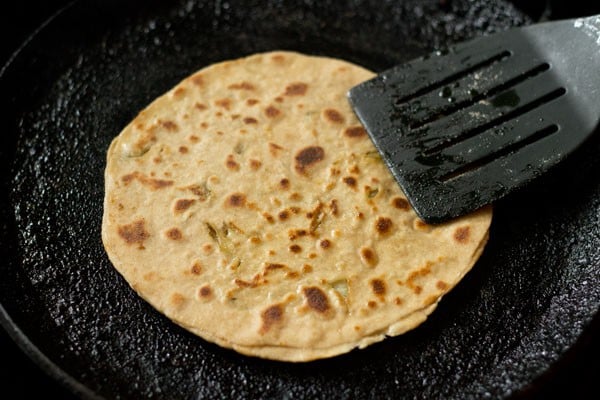
7. Make all paratha this way and stack them in a roti basket or a casserole. While cooking the second paratha, if there are any burnt or browned wheat flour particles on the tawa then you can wipe them with a kitchen paper towel.
Also regulate the heat as needed while roasting the paratha.

8. Serve cabbage paratha for breakfast with a side accompaniment of lemon pickle or mango pickle. You can also serve with some butter or curd. For a delicious tea time snack you can serve these with chai.
For more delicious cabbage recipes, you can check this collection of Cabbage Recipes.
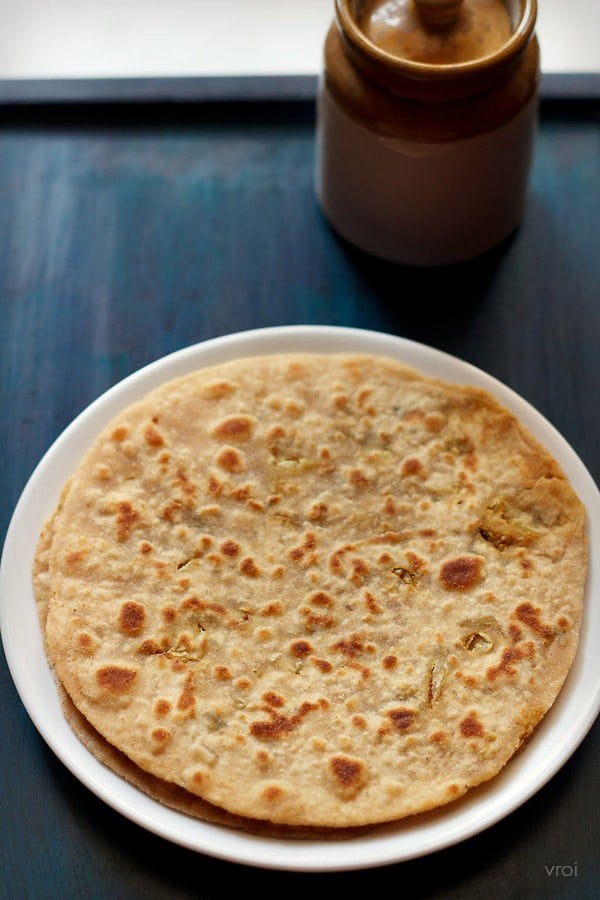
More Stuffed Paratha Recipes!
North Indian Food
Breakfast Recipes
Breakfast Recipes
Breakfast Recipes
Please be sure to rate the recipe in the recipe card or leave a comment below if you have made it. For more vegetarian inspirations, Sign Up for my emails or follow me on Instagram, Youtube, Facebook, Pinterest or Twitter.
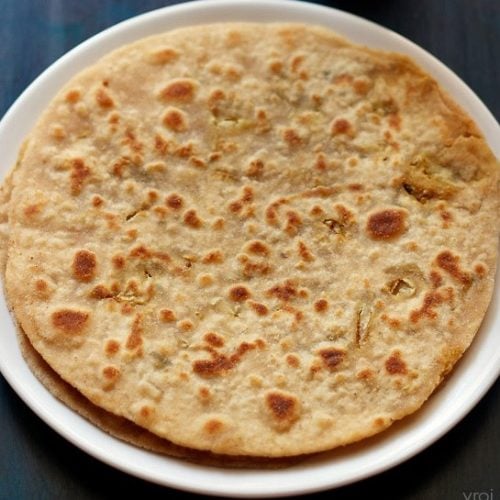
Cabbage Paratha (Patta Gobhi ka Paratha)
Ingredients
For paratha dough
- 2 cups whole wheat flour (atta) – 240 grams
- 2 teaspoons oil
- ⅔ cup water or add as required
- ¼ to ½ teaspoon salt or add as required
For cabbage stuffing
- 350 grams cabbage or 4 cups tightly packed shredded or chopped cabbage (patta gobhi or bandh gobi)
- 1 tablespoon oil
- ½ teaspoon carom seeds (ajwain)
- 1 or 2 green chilies chopped or 1 teaspoon finely chopped green chilies
- 1 teaspoon finely chopped ginger
- ¼ teaspoon turmeric powder (ground turmeric)
- ¼ teaspoon red chilli powder or cayenne pepper or paprika
- ½ teaspoon Coriander Powder (ground coriander)
- ½ teaspoon cumin powder (ground cumin)
- ½ teaspoon Garam Masala
- ½ teaspoon amchur powder (dry mango powder)
- salt as required
For Roasting
- oil or ghee for roasting, as required
Instructions
Making dough
- In a mixing bowl or pan take 2 heaped cups whole wheat flour, 2 teaspoon oil, ½ teaspoon salt or add as required. Add ½ cup water.
- Mix and then knead the dough. Add more water if required to make a smooth soft dough.
- Cover and allow the dough to rest for 20 to 30 minutes.
Making cabbage filling
- Peel and remove the top skin from the cabbage (patta gobhi or band gobi). Rinse. Quarter the cabbage and blanch in hot water for 5 to 10 minutes.
- Then shred cabbage or chop it. I used 350 grams cabbage, which yielded 4 cups tightly packed shredded cabbage.
- Heat 1 tablespoon oil in a pan or kadai. Splutter ½ teaspoon ajwain seeds (carom seeds). You can also use ½ teaspoon cumin seeds instead of ajwain seeds.
- Then add the shredded cabbage. Stir and mix very well.
- Season with salt as required.
- Cover the pan with a lid.
- Steam the shredded cabbage on a low flame till they turn translucent. This takes about 7 to 8 minutes on a low heat.If in case the cabbage starts sticking onto the pan or getting browned, add a splash of water. Mix and deglaze. Continue to cover and cook. Do keep in mind that the stuffing when cooked should not have any water in it.
- Then add finely chopped green chilies, finely chopped ginger, turmeric powder, red chilli powder, coriander powder, cumin powder, garam masala powder and amchur powder (dry mango powder).
- Mix the ground spice powder and green chilies very well with the cabbage. Check the taste and add more salt, red chili powder or dry mango powder if required.
- Lastly add 2 tablespoons coriander leaves and switch off the heat.
- Mix the coriander leaves very well with the rest of the spiced cabbage stuffing. Allow this stuffing to cool down at room temperature.
Assembling and stuffing cabbage paratha
- Later pinch two small to medium sized balls from the dough. Then on a rolling board, dust some dry wheat flour on both sides of the balls.
- Roll them to about 4 to 5 inches diameter rounds . Try making both the rounds of the same size.
- On one of the rolled dough circle, place the cabbage stuffing in the center and keep about 1 inch empty space from the sides.
- Gently place the second circle on top. Press and seal the edges very well with your fingertips.
- Dust some flour on both sides of the stuffed cabbage paratha. Roll the paratha into a circle of about 7 to 8 inches in diameter or about the size of a normal roti or chapati.
cooking cabbage paratha
- On a hot tava (skillet or griddle) place the rolled cabbage paratha. The tava should be hot and not at a low temperature.
- Cooking cabbage paratha at a low heat will harden them. Parathas ideally are crisp as well as soft.
- When the base is partly cooked, then flip the paratha with the help of a spatula or tongs. Spread with a sppon some ghee or oil on the partly cooked part.
- Flip again and this time this side has to be cooked more than the previous side. You will see brown spots on the paratha.
- Spread some ghee or oil on this side too.
- Flip again once or twice till both the sides are cooked properly.
- You should see crisp brown spots on the paratha.
- You can also press the paratha edges with a spatula or spoon so that they are fried well. Since at times, the paratha edges are not cooked well.
- Make all paratha this way and stack them in a roti basket or a casserole.
- While cooking the second paratha, if there are any burnt or browned wheat flour particles on the tawa then wipe them with a kitchen paper towel.
- Serve cabbage paratha for breakfast with a side accompaniment of lemon or mango pickle. You can also serve with some butter or curd.
Notes
Nutrition Info (Approximate Values)
This cabbage paratha post from the blog archives first published in December 2015 has been republished and updated on 10 January 2022.

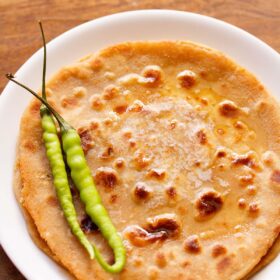
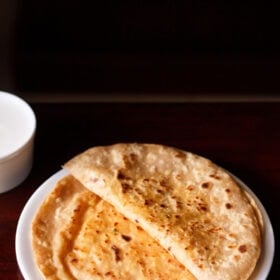
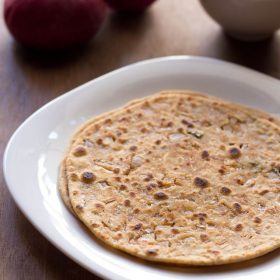








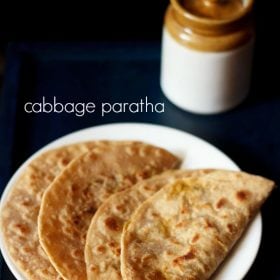
Tried this by the easy method of mixing all the ingredients in the flour.not only was it simple and quick but also super delicious.loved it with a side accompaniment of mango pickle.
thanks again winnie. thanks for the rating too.
Hello dassna dis recipe is really grt
Can add potato with cabbage?
Thanks Gousia, Yes you can add mashed potatoes.
Hi, i tried the cabbage paratha recipe and it turned out great. loved it!! I follow a lot of your recipes and really like the way you break down the recipes and simplify them. Keep it going… im a fan of your veg recipes of india 🙂
thanks a lot jayna for your feedback and your positive words. happy cooking 🙂
Hi Dasanna ma’am, Thanks for the recipe. It tried this out with some left over cabbage and it turned out very well. Your recipes always come out perfect 🙂
I had one query, this is in general regarding the tawa. I have observed some folks using a concave shaped tawa for making roti/chapathi/paratha, whereas I have always used flat based griddle. Does the shape of the tawa/griddle matter in the way the roti is cooked?
welcome bhuvana. yes the shape does make a difference in the taste. i also use a flat tawa as the the concave one i have is very heavy.
Tried this today. Ma folks loved it. Thanks dassanna
welcome aditii